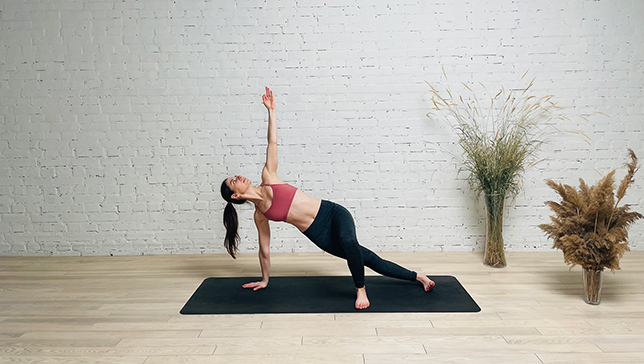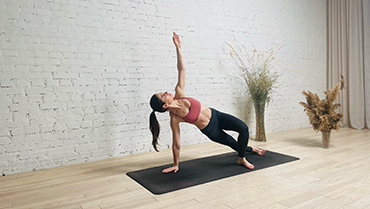Supported Side Plank Pose - Salamba Vasisthasana

Contents
Supported Side Plank Pose, or Salamba Vasisthasana in Sanskrit, is a modified version of Side Plank Pose. With the top leg bent and foot flat on the floor, the pose is more accessible to those who find it difficult to balance with the feet stacked. This variation still strengthens the legs, core and arms.
Salamba vasisthasana strengthens the entire working side of the body, the foot on the ground acts as training wheels that allow you to focus on the alignment and the very tricky balancing aspect of the pose.
Pose Detail
- Body Position: Arm & Leg Support
- By Type: Balancing Yoga Poses, Strengthening Yoga Poses
- Difficulty: Beginners
- By Benefit: Yoga Poses For Stress Relief, Yoga Poses For Weight Loss
Step-by-Step Instructions
Benefits and Contraindications
Builds core strength
Relieves stress and improves concentration
Lengthens the spine
Improves balance
Strengthens the legs, arms, shoulders, and wrists
Stretches the wrists
Develops focus
Carpal tunnel syndrome
Elbow, shoulder, or wrist injury
Tendonitis
Photo poses in different angles

Modifications, Props and Tips
- Placing a block under your bottom hand can provide additional support and stability, especially if you’re new to the pose. You can use a lower or higher block depending on your comfort level.
- Practicing the pose with your bottom hand against a wall can provide additional support and help you maintain proper alignment.
- If you want to challenge yourself, you can lift your top leg higher towards the ceiling, or even lift your top arm towards the ceiling as well.
- To maintain stability in the pose, engage your core muscles and draw your navel towards your spine.
- To help maintain balance, keep your gaze forward and avoid looking up or down.
Frequently Asked Questions
The frequency of your Side Plank pose practice will depend on your individual needs and goals, as well as your level of experience and comfort with the pose. It can be incorporated into a daily or weekly yoga practice, or used as a warm-up or cool-down for other physical activities. It’s important to listen to your body and practice in a way that feels safe and sustainable for you.
Side Plank pose can help strengthen and tone the muscles of the core, arms, and legs, which can contribute to an overall increase in muscle mass and a higher metabolic rate. However, it is not a targeted exercise for burning fat, as spot reduction is not possible. In order to lose fat, a combination of regular exercise, a healthy diet, and overall calorie deficit is necessary. Side Plank pose can be a helpful addition to a well-rounded fitness routine, but it should not be relied upon as the sole method of burning fat.
Variations
- Side Plank Pose
- Side Plank with Knee Tuck
- Side Plank with Leg Lift
- Side Plank with Arm Reach